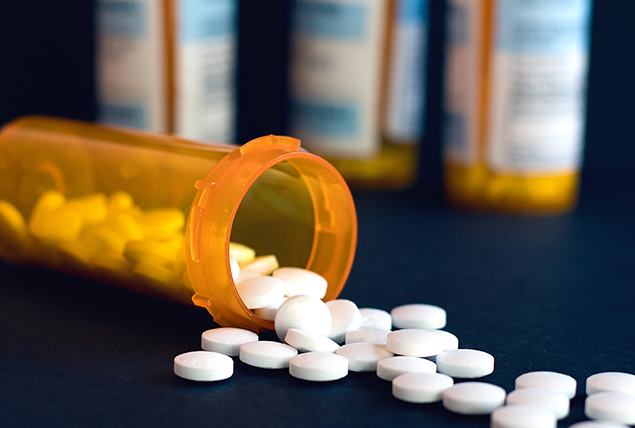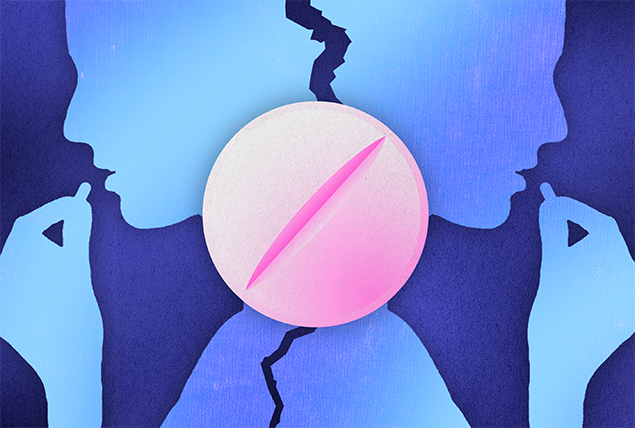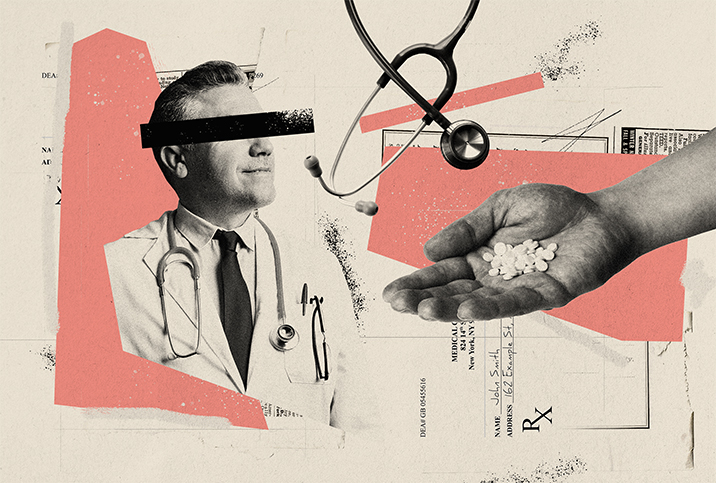Effects of Opioid Use Disorder Can Put Relationships and Life at Risk

Key Points
- Opioid use disorder can be destructive and even deadly, but it is highly treatable with professional intervention and care.
- Common examples of opioids include morphine, hydrocodone, oxycodone, fentanyl and heroin. About 75 percent of people who use heroin start by taking opioid painkillers, according to the National Institute on Drug Abuse.
- The amount and length of time required to develop dependence depends on the individual and drug, among other factors, but research indicates it can take as little as five days.
- One 2018 study reported long-term opioid users were almost 70 percent more likely than the general population to experience sexual difficulties and more than twice as likely to have low libido.
Opioid use disorder (OUD) is a serious illness that can dramatically impact a person's well-being and put their life at risk. More than 3 million people in the United States have or have had OUD, a subset of substance use disorder (SUD), per the National Library of Medicine.
In 2021, approximately 80,400 people in the U.S. died from OUD-related causes. The effects of opioid use disorder are serious.
A broad class of illicit and pharmaceutical drugs fall under the umbrella of opioids. These drugs interact with opioid receptors in the brain and body to block pain signals and elicit a sense of relaxation and euphoria. The drugs—they come in myriad formulations—can be manufactured from poppy seed extracts or in a laboratory. Common examples include morphine, hydrocodone, oxycodone, fentanyl and heroin.
The World Health Organization (WHO) recognizes many types of opioids as essential medicines with legitimate uses in treating severe pain, including that caused by fractures or surgery. However, opioids can be and are frequently misused due to their potency and addictiveness.
Not all people who take opioids develop OUD. According to Mayo Clinic, up to one-third of people who take opioids misuse them, and 10 percent or more become addicted.
Opioid use disorder can be destructive and even deadly, but it is treatable with professional intervention and care. Understanding what opioid use disorder is, as well as its signs and symptoms, can help you identify if you or a loved one needs help.
What is opioid use disorder?
According to Johns Hopkins Medicine, substance use disorder is a recognized mental disorder that affects a person's brain and behavior. People with this condition demonstrate problematic patterns of using a substance, such as opioids, that negatively impact their lives and well-being. For example, usage may cause the person to engage in dangerous behaviors, miss work or school, or be isolated from family and friends.
Substance use disorder can involve using illegal drugs, such as heroin or methamphetamine, or legal substances, such as prescription painkillers, sleeping pills, nicotine or alcohol.
Alcohol use disorder is the most prevalent type of substance use disorder in the U.S., according to Mental Health America. The Substance Abuse and Mental Health Services Administration (SAMHSA) estimates that more than 17 million people have an alcohol use disorder. Excessive alcohol use is the cause of about 88,000 deaths a year, according to the Centers for Disease Control and Prevention (CDC).
The terms addiction and substance use disorder are sometimes used interchangeably, but not all people who misuse substances are addicted to them. According to Cleveland Clinic, SUD can range from mild to severe, with addiction being the most serious form.
Both addiction and substance use disorder can involve a physical dependence on the substance. When a person is dependent on a drug, they need more and more of it to experience the same effect and to avoid withdrawal and discontinuation symptoms. Anyone with SUD can experience psychological cravings and compulsions, but they are more severe in people with addiction.
"Addiction includes both a physical and psychological dependence and is marked by a change in behavior so that drug use becomes a priority despite negative consequences," said Martha Koo, M.D., the medical director at Clear Behavioral Health, with locations throughout California.
Many people develop OUD after receiving prescription opioid medication. The amount of medication and the length of time required to develop dependence depends on the individual and the drug, among other factors, but some research indicates it can take as little as five days, according to Koo. About 75 percent of people who use heroin start by taking opioid painkillers.
Why are opioids addictive?
The sensations opioids produce can be overwhelming and compelling. That's especially so because exogenous opioids stimulate opioid receptors more effectively than endogenous ones, according to Paulo Negro, Ph.D., M.D., a medical and addiction advisor at All Sober in Maryland. This stimulation causes a surge in dopamine and endorphins, with levels of these chemicals far surpassing what would occur in response to natural rewards like food.
"Opioids are extremely addictive because they activate powerful brain reward centers," Koo said. "Opioid use results in the release of endorphins and dopamine, causing an increased sense of pleasure compared to natural rewards as well as the eradication of pain. This experience of pleasure, coupled with the avoidance of physical pain and negative emotions, becomes a powerful incentive to continue opioid use."
Opioids also decrease activity in the brain's stress system, centered in the amygdala, according to Christine DeFranco, D.O., an emergency medicine physician at Holy Name Medical Center in Teaneck, New Jersey. This can alleviate uncomfortable feelings such as fear and anxiety and intensify the desire to use again.
Over time, substances of addiction hijack the pleasure-reward pathway in the brain, while dopamine surges mask the anti-reward pathway, DeFranco added. As a result, a person's perception of the harmful effects of the drug diminishes while their cravings intensify.
She noted that over time, two effects of opioid use disorder get more prevalent: Dopamine surges dwindle and the body builds a tolerance. A person must take more and more of the drug to achieve the desired effect.
"Ultimately, a person's addiction morphs from pursuing rewards and excitation to a desperate attempt to avoid pain, and people will take great risks," DeFranco said.
People who misuse opioids may try switching from one opioid to another or combine them with substances like alcohol or benzodiazepines in an attempt to enhance the drug's effects, according to Dung Trinh, M.D., the chief medical officer at Healthy Brain Clinic in Long Beach, California.
"This increases the risk of overdose and death," he said. "With proper treatment, however, people with opioid use disorder can recover and live healthy lives."
Recommended
- How Do Opioids Affect the Brain and What Are They?: This broad class of pain relievers is effective but there are long-term effects of opioid use.
- Why Would Anyone Take Fentanyl?: Capable of a potency up to 100 times that of morphine, this opioid poses a real risk.
- Options for Managing Pain Without Opioids: Are you living with chronic pain but don't want to resort to narcotics? You have options.
Symptoms of opioid use disorder
Opioid use disorder prominently affects the brain and body and can produce multiple psychological, physical and behavioral symptoms. According to the American Psychiatric Association and Johns Hopkins Medicine, some of the most prevalent symptoms of opioid use disorder include the following:
- A pattern of unsafe or unhealthy use. A person continues using opioids despite significant adverse consequences and engages in increasingly problematic behaviors related to usage. For example, they might take opioids under dangerous circumstances, like while driving a car, or put themselves in precarious situations to obtain the drug.
- Cravings. Someone may feel a powerful desire to take the drug, despite being aware of potential consequences.
- Interference with daily life. Most people with opioid use disorder find their disorder interferes with everyday life, including work, school, relationships and family obligations.
- Misuse. Taking opioids outside the parameters of a doctor's prescription may indicate a problem. For example, taking more than the prescribed dose or using them for longer than the prescription indicates.
- Physical dependence. This physiological phenomenon indicates that if a person stops taking the drug, they'll experience effects such as sweating and cravings. Importantly, a person can be physically dependent on a substance without having a substance use disorder.
- Spending excessive time and effort. A person with OUD may spend substantial time and go to great lengths to obtain the drug. They may also expend extensive time and energy using opioids and recovering from the effects, including withdrawals.
Side effects of opioid use disorder can affect the entire body, according to Ryan Peterson, M.D., a Los Angeles-based pain management physician at NuView Treatment Center. These include stomach ache, dry mouth, headaches, drowsiness, sleepiness, mood changes, nausea, vomiting, constipation, low libido and loss of appetite.
Moreover, people with OUD may lack personal hygiene, isolate themselves from friends and family, and experience new financial difficulties due to their disorder. Some may steal from family or friends or engage in other uncharacteristic behaviors to obtain the drug. Many people try to curb or stop their opioid use alone but cannot do so without professional help.
If a person takes too much or overdoses, it can result in difficulty breathing, extreme drowsiness and a slow heart rate, Peterson said. These symptoms might indicate a medical emergency. Overdosing can be fatal.
Koo noted that intravenous opioid use can also lead to HIV, hepatitis B and C, heart infection (endocarditis), and vein infection (phlebitis).
Risk factors for opioid use disorder
As with most mental health disorders, there's no single cause of OUD or SUD in general, according to Koo. Instead, multiple factors can increase a person's risk.
"In the broadest terms, substance use disorders are caused by a combination of factors," Koo said. "Biological, as in genetics, [and] psychological and environmental, such as family dynamics and individual experiences."
Research indicates that for most SUDs, genetics play a significant role, Koo added, and most people with OUD have a family member with a history of substance use disorder.
According to Koo and Peterson, other risk factors for developing SUDs include:
- A personality characterized by risk-taking, thrill-seeking and impulsivity
- Chronic illness, including chronic pain
- Co-existing psychiatric conditions, such as depression, anxiety, attention-deficit/hyperactivity disorder (ADHD), manic depressive disorder or post-traumatic stress disorder (PTSD)
- Early substance use
- Emotional distress, including intense stress
- Lack of family or other social support
- Multiple adverse childhood experiences, such as abuse, neglect or divorce
- Peer pressure
- Poverty
- Terminal illness
- Unemployment
"Substance use disorders are mainly driven not just by addiction to pain medications but also to one's quality of life," Peterson said. "Based on my own experience and practice, people who are in distress and living in depressed communities and stressful situations, often resort to substance abuse as a way to 'escape.' Substance use and mental illnesses have a strong correlation and should be considered when a person is suspected of having a substance use disorder."
Alcohol Consumption—The Good, the Bad and the Ugly: As a cultural beverage, it’s universal—but there can be consequences to drinking too much.
The impact of opioids on sexual health
Opioid use can diminish sexual function by affecting the hypothalamic-pituitary-gonadal pathway, a key hormone system that regulates testosterone, according to Koo. This can result in diminished libido and erectile dysfunction.
One 2018 study published in the journal Pain Medicine reported long-term opioid users were almost 70 percent more likely than the general population to experience sexual difficulties and more than twice as likely to have low libido. About 82 percent of short-term users reported low libido and 35 percent indicated sexual dissatisfaction.
Opioid use disorder can affect fertility, too. Research suggests that by diminishing testosterone and estradiol levels, opioid use can impede testicular function and reduce sperm quality in men. For women, opioids decrease the production of the sex hormones estrogen and progesterone and interfere with ovulation, leading to irregular periods and reduced fertility, or infertility.
Women who become pregnant while using opioids have a higher risk of complications, according to the organization, March of Dimes. These include preterm birth, miscarriage, stillbirth, preeclampsia, placental abruption, low birth weight, congenital disabilities and poor developmental outcomes.
Common congenital disabilities associated with opioid use include:
- Congenital heart defects
- Gastroschisis (a condition where the baby's intestines emerge outside the body through a hole near the navel)
- Glaucoma
- Neural tube defects (e.g., spina bifida)
Babies born to a person using substances while pregnant are also susceptible to neonatal abstinence syndrome (NAS), where a baby goes through withdrawals after being exposed to drugs while in utero. According to March of Dimes, NAS can occur even if a pregnant person is using medications as prescribed by their physician.
The bottom line
If you or someone you love is struggling with opioid use, there are many online resources you can investigate, including the following:
- The Substance Abuse and Mental Health Services Administration (SAMHSA) helpline at 800-662-4357 (HELP) offers confidential free help, from public health agencies to find substance use treatment and information.
- The Centers for Disease Control and Prevention (CDC) offers tools and information for healthcare professionals working on overdose prevention and treatment.
- The American Society of Addiction Medicine provides a guide for patients, families, and friends, including information on the assessment, treatment overview and all the medications available to treat opioid use and overdose.
Make sure to keep your doctor included in all decisions made concerning substance use in general and opioid use in particular.


















